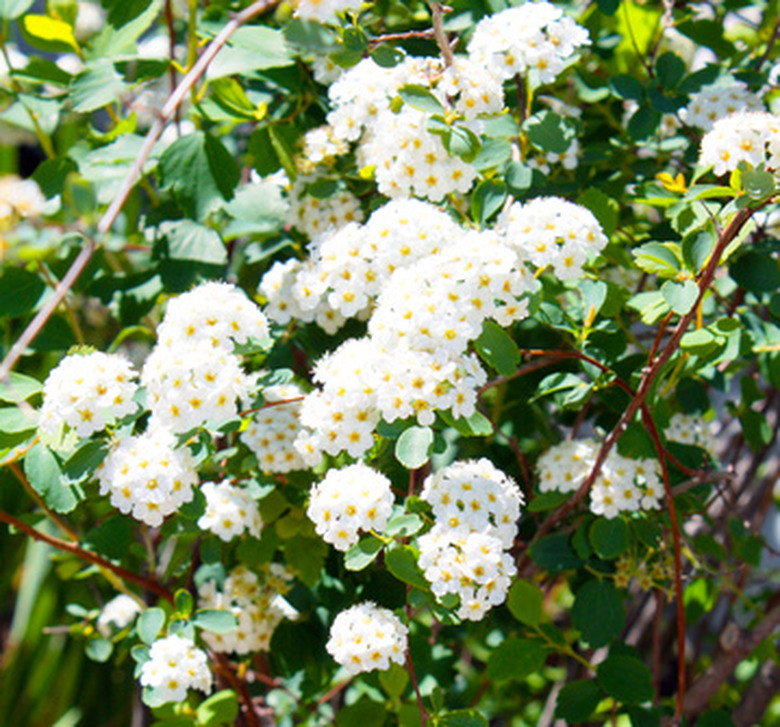How To Propagate A Snowball Viburnum
Things Needed
- 4-inch pot with drainage hole
- Commercial potting mixture
- Sand
- Saucer of water
- Sharp knife or garden shears
- Clear 1-liter plastic soda bottle
- 6-inch pot with drainage hole
Snowball viburnum (Viburnum macrocephalum) is a showy ornamental shrub that will never fail to impress onlookers with its round clusters of tiny blossoms that start out apple green in late spring, then turn into pure white snowballs, with shiny green leaves in vivid contrast. A deciduous evergreen shrub, snowball viburnum will stay green all year round in temperate climates. Snowball viburnum can be propagated by taking a cutting from a healthy shrub in late spring.
Step 1
Fill a 4-inch pot with a mixture of half commercial potting mix and half sand. Place the pot in a saucer of water and allow the soil to wick water through the drainage hole in the bottom of the pot. Remove the pot from the saucer of water when the potting mixture is damp clear through but not dripping.
Step 2
Use a sharp knife or garden shears to cut a 4- to 6-inch stem from a healthy viburnum bush. The stem should be green but should snap when you bend it. If the stem bends but won't break, the stem is too young. If the stem is so woody that it won't bend, the stem it too old. Make the cut just below a leaf or a bud, and be sure the stem has at least four leaves.
- Snowball viburnum (Viburnum macrocephalum) is a showy ornamental shrub that will never fail to impress onlookers with its round clusters of tiny blossoms that start out apple green in late spring, then turn into pure white snowballs, with shiny green leaves in vivid contrast.
- Make the cut just below a leaf or a bud, and be sure the stem has at least four leaves.
Step 3
Strip the leaves from the lower half of the viburnum stem, leaving two upper leaves intact. Using kitchen shears, cut the remaining leaves in half. Smaller leaves will require less room in the pot, and will prevent excess loss of moisture through the leaves.
Step 4
Dip the cut end of the stem in powdered rooting hormone. Plant the stem in the pot, with the leaves above and not touching the potting mixture. Try not to scrape off too much rooting hormone as you plant the stem. Several viburnum stems can be planted, leaves not touching, in the same container.
- Strip the leaves from the lower half of the viburnum stem, leaving two upper leaves intact.
- Plant the stem in the pot, with the leaves above and not touching the potting mixture.
Step 5
Cut the bottom from a clear 1-liter soda bottle. Place the pot of viburnum stems in bright, indirect sunlight, and put the soda bottle over the pot so it will act as a miniature greenhouse. Don't let the plastic touch the leaves.
Step 6
Check the potting mixture several times each week. The plastic bottle will keep the soil moist for several days. If the top of the potting mixture is dry to the touch, mist the potting mixture immediately. The potting mixture should be just damp, but should never be allowed to dry out. If you notice drops of condensation on the inside of the soda bottle, remove the lid for a few hours to allow air circulation.
- Cut the bottom from a clear 1-liter soda bottle.
- If you notice drops of condensation on the inside of the soda bottle, remove the lid for a few hours to allow air circulation.
Step 7
Watch for new growth to appear in one to two months, which will indicate that the viburnum stem has rooted. Remove the plastic bottle from the container, and place the viburnum cutting in bright sunlight. Continue to water as needed to keep the soil damp.
Step 8
Move the rooted viburnum stem into a 6-inch container filled with commercial potting mix as soon as the roots are one to two inches long. Allow the viburnum to grow for several weeks, then plant the new viburnum bush in its new home outdoors. The longer the viburnum is allowed to grow before it's planted outdoors, the better the chances of success will be.
